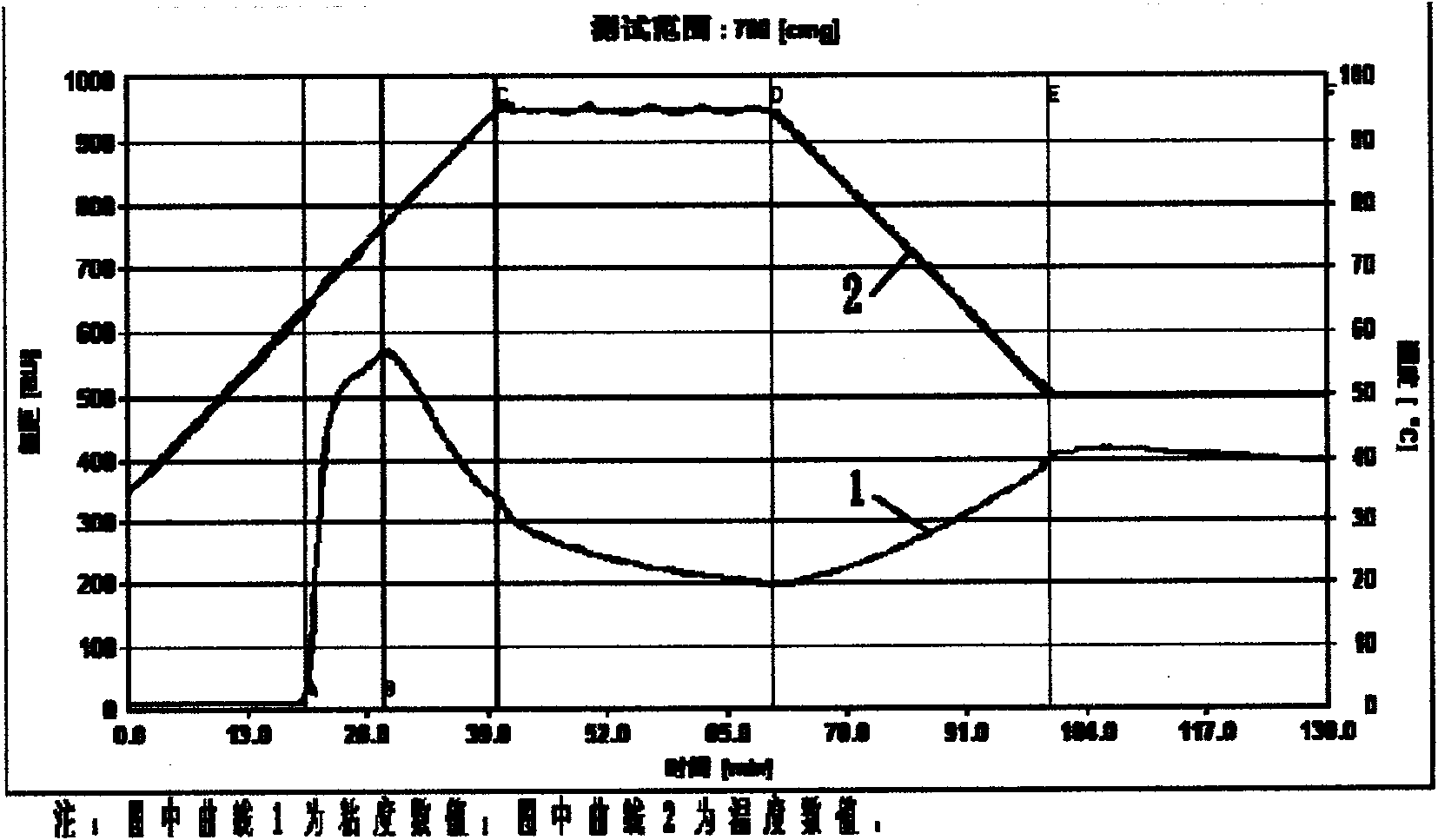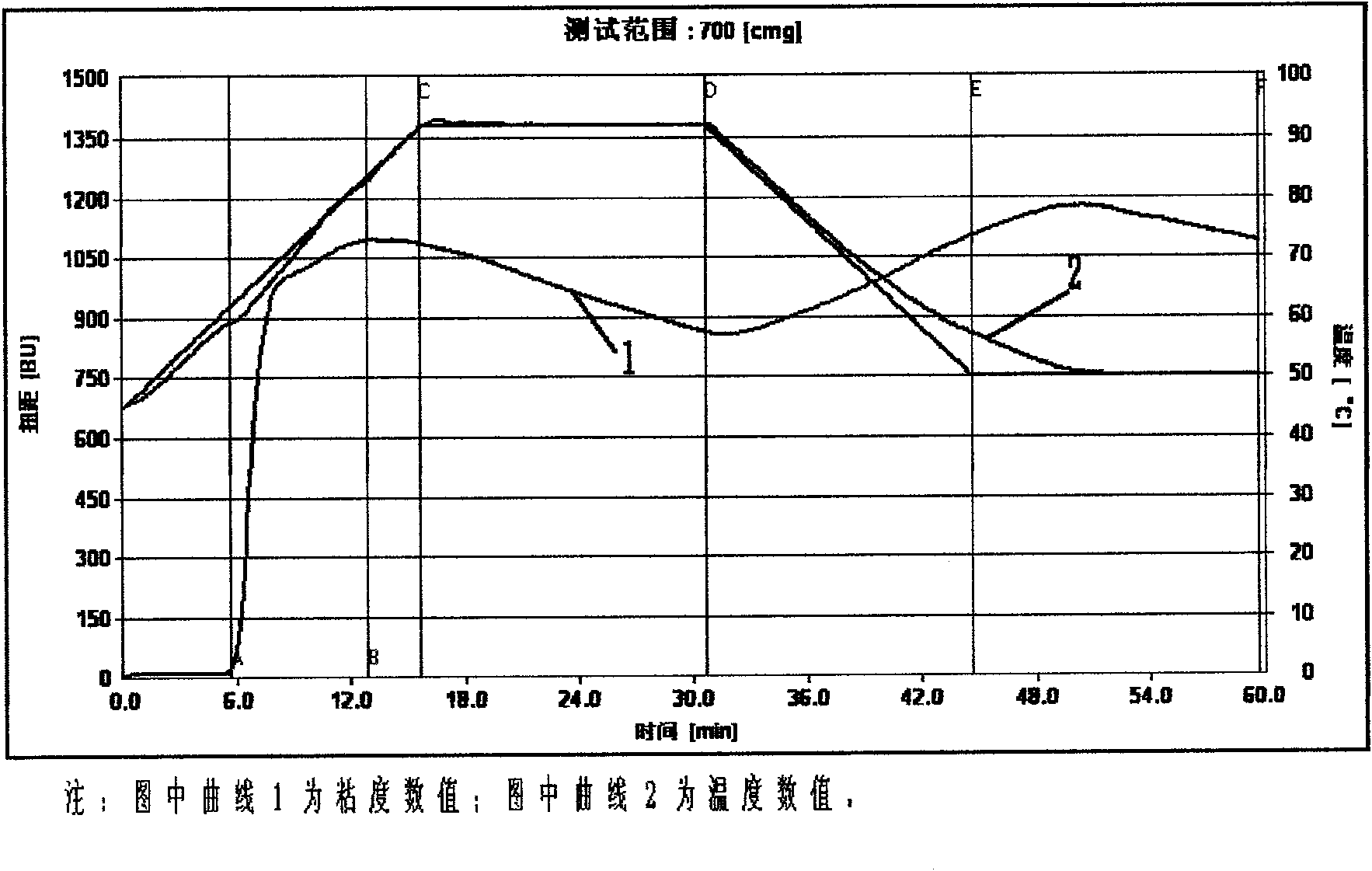Composite modified starch, preparation method and application thereof
A technology for compounding modified starch and starch, applied in food preparation, application, food science and other directions, can solve the problems of acetic anhydride being irritating, unsuitable for the food industry, and having a starchy taste in the mouth, achieving good freeze-thaw stability and convenience. Promotion and use, strong water retention effect
- Summary
- Abstract
- Description
- Claims
- Application Information
AI Technical Summary
Problems solved by technology
Method used
Image
Examples
Embodiment 1
[0036] The preparation of embodiment 1 potato compound modified starch
[0037] Prepare potato compound modified starch according to the following steps:
[0038] 1. Dissolve 3.0 grams of sodium sulfate and 0.2 grams of sodium hydroxide in 100 grams of demineralized water, and stir thoroughly to obtain a uniform solution;
[0039] 2. Add 100 grams of potato starch to the above solution, mix evenly, adjust the pH value to 10.0 with 4% by mass sodium hydroxide solution, and heat it to 42°C in a water bath to obtain starch milk;
[0040] 3. Add 0.05 g of sodium trimetaphosphate to the above starch milk, keep the pH value at 10.0 and react for 2.5 hours;
[0041]4. Neutralize the starch milk pH to 8.0 with 10% hydrochloric acid, and then cool down to 20°C;
[0042] 5. Add 0.4 g of succinic anhydride for esterification, and maintain the pH value at 8.0. After the reaction is completed (when the succinic anhydride is added and the pH value no longer changes), neutralize the pH of ...
Embodiment 2
[0044] The preparation of embodiment 2 cassava compound modified starch
[0045] Prepare cassava compound modified starch according to the following steps:
[0046] 1. Dissolve 5.0 grams of sodium chloride and 0.8 grams of potassium hydroxide in 150 grams of demineralized water, and stir thoroughly to obtain a uniform solution;
[0047] 2. Add 100 grams of tapioca raw starch to the above solution, mix evenly, adjust the pH value to 11.5 with a sodium hydroxide solution with a concentration of 4% by mass percentage, and heat it to 42°C in a water bath to obtain starch milk;
[0048] 3. Add 0.03 g of sodium trimetaphosphate to the above starch milk, keep the pH value at 11.5 and react for 2.5 hours;
[0049] 4. Use 10% hydrochloric acid to neutralize the pH value of the starch milk to 9.0, and then lower the temperature to 30°C;
[0050] 5. Add 0.5 g of succinic anhydride for esterification, and maintain the pH at 9.0. After the reaction is completed, neutralize the starch mil...
Embodiment 3
[0052] The preparation of embodiment 3 corn composite modified starch
[0053] Prepare corn composite modified starch according to the following steps:
[0054] 1. Dissolve 1.0 g of sodium sulfate and 0.2 g of sodium hydroxide in 100 g of demineralized water, and stir thoroughly to obtain a uniform solution;
[0055] 2. Add 100 grams of raw corn starch to the above solution, mix well, adjust the pH value to 11.5 with a sodium hydroxide solution with a concentration of 4% by mass percentage, and heat it in a water bath to 42°C at the same time to obtain starch milk;
[0056] 3. Add 0.01 g of sodium trimetaphosphate to the above starch milk, keep the pH value at 10.0 and react for 1.5 hours;
[0057] 4. Use 10% hydrochloric acid to neutralize the pH value of the starch milk to 9.0, and then lower the temperature to 30°C;
[0058] 5. Add 0.3 grams of succinic anhydride for esterification, and maintain the pH value at 9.0. After the reaction is completed (when the succinic anhyd...
PUM
 Login to View More
Login to View More Abstract
Description
Claims
Application Information
 Login to View More
Login to View More - R&D
- Intellectual Property
- Life Sciences
- Materials
- Tech Scout
- Unparalleled Data Quality
- Higher Quality Content
- 60% Fewer Hallucinations
Browse by: Latest US Patents, China's latest patents, Technical Efficacy Thesaurus, Application Domain, Technology Topic, Popular Technical Reports.
© 2025 PatSnap. All rights reserved.Legal|Privacy policy|Modern Slavery Act Transparency Statement|Sitemap|About US| Contact US: help@patsnap.com



